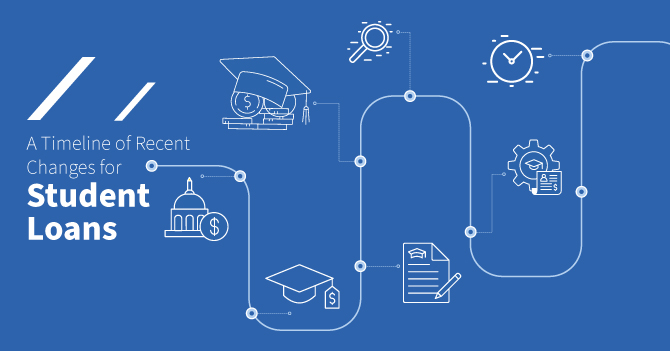When the coronavirus pandemic was at its height, many faced financial hardship due to layoffs, an inability to do their job, economic uncertainty, and a host of other reasons. One of the responses to these hardships was a forbearance, or temporary pause, on student loan repayments enacted by the federal government. While that initial decision went into effect almost four years ago in March 2020, there have been various plans, proposals, decisions, setbacks, and successes that have occurred since then. Our infographic traces the timeline of changes that have taken place in the world of student loans since March 2020, through the end of 2023 and provides a look ahead to 2024, when another change will occur.
After the initial pause on student loans in March 2020, the COVID-19 pandemic continued to cause economic issues and there was little movement around the issue of student loans until over two years later. In April 2022, the U.S. Department of Education announced an Income-Driven Repayment (IDR) plan and Public Service Loan Forgiveness (PSLF), one-time account adjustments that were projected to impact millions of borrowers. About six months later in October 2022, the Joint Consolidation Loan Separation Act was passed by Congress. This legislation allows borrowers who previously consolidated their student loans with a spouse to separate them and access debt relief programs such as PSLF.
By the beginning of June 2023, the United States was in a race against the clock, attempting to pass a debt-ceiling deal through Congress that would prevent a first-ever default. On June 2nd, 2023, a deal passed Congress that suspended the U.S. government's $31.4 trillion debt ceiling and avoided a default with only a few days to spare. One of the numerous provisions in the deal put an end to the freeze on student loan repayments and restricted the government’s ability to reinstitute such a measure. President Biden still tried to pass legislation that would erase up to $20,000 of a borrower’s federal student loan debt, but the proposal was struck down by the United States Supreme Court on June 30, 2023. The countdown to student loans accruing interest again on September 1st and payments resuming on October 1st had begun.
However, some borrowers were granted relief on July 14, 2023, when the Department of Education announced the first major wave of loan forgiveness for over 804,000 borrowers who had been paying their loans back for at least 20 years. Later that month on July 30th, parts of the IDR plan went into effect. Income exemption for student loans increased to 225% of the poverty guideline and interest stopped accruing on loans in which the borrower makes a payment under IDR.
As part of the debt-ceiling deal, the freeze on student loans ended August 2023 and the pause was not to be resumed, so on September 1st, 2023, student loans once again began accruing interest. A month later, on October 1st, 2023, student loan payment requirements resumed, effectively ending about a three and a half year pause and returning the student loan world to a state of relative normalcy.
Later this year, on July 1st, 2024, the rest of the IDR plan will go into effect. This part of the IDR plan includes loan forgiveness for small-balance loans, consolidation penalty on federal loans will be lifted, and monthly bills will be halved to 5% of income above 225% of the poverty line, among other provisions. This is the final major change in student loans that resulted from the initial pause to student loans in March 2020 as a response to the coronavirus pandemic. It has been a rollercoaster few years regarding student loans, and in particular 2023 presented a number of rapid and radical shifts. While the plans and actions detailed in this infographic will be completed by mid-2024, student loans and student loan forgiveness will surely remain a topic of conversation among borrowers, legislators, and the general public.



Comments